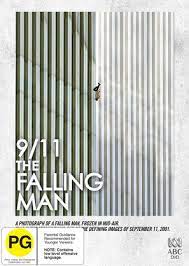
9/11: THE FALLING MAN
UK, 2006, 80 minutes, Colour.
Narrated by Steven Mackintosh.
Directed by Henry Singer.
This is a British documentary, not an American documentary. While it has graphic sequences throughout, it brings the 9/11 American experience vividly to the screen. It is narrated in a quietly measured way by actor, Steven Mackintosh. The director, Henry Singer, was to go on to make quite a number of strong documentaries.
The film was released five years after the events, enabling audiences around the world to go back to the images, the experiences, the shock, the grief, bewilderment. And, seen in succeeding decades, it still holds audience attention.
The film draws on familiar footage of the impact of the plane crash on the North Tower, the direct filming of the second crash into the South Tower. And there is the footage of the collapse of both buildings. There are scenes of bewilderment of observers on the ground. Scenes of firefighters and rescue is going to their work. There is also the personal effect with interviews with a number of survivors, especially the chef at the renowned restaurant at the top of the North Tower, Window to the World. And there are survivors who relate the stories of their phone calls and texting to spouses and partners trapped in the upper stories of the towers. These will always make an impact because of the personal involvement.
(The film, Worth, of 2020, offers background to the tragedy, to the survivors, to their relations, in terms of the Victim Compensation Fund, the focus on its administration by Kenneth Feinberg over two years, the critique by Charles Wolf about the approach of the fund, the transition from the application of regulations and conditions to the listening to the stories.)
However, as the title indicates, there is a focus on the photo of The Falling Man, one of the many who fell from the upper stories of the towers. Photographer Richard Drew captured the moments of one particular man falling. It was reproduced in the media, the film shows the Allentown, Pennsylvania, staff and their deliberations as to whether to publish or not – and the angry reaction of the public to the publication, to the effect on the public as they looked at the photo and, for a while, the photo disappeared.
Crucial to the film is the work of a journalist who investigated who the falling man might be, coming to the conclusion that it was one of the cooks in the restaurant, contacting his family who reacted very badly, a Hispanic Catholic family who felt that identifying him and suggesting he jumped made him a suicide and, according to their beliefs, gone to hell.
Another investigator was motivated to check on the identity of the Falling Man, enlisting the aid of a private detective, looking at the photos of those who had disappeared, on the walls around the World Trade Centre site, selecting those who physically resembled the photo of the falling man.
To this extent, the film is an investigation, suggesting possibilities, eliminating candidates, attempting to interview relatives and friends, including the chief chef of Window to the World, who ultimately does agree and there seems to be some consensus that this man might have been a cinematographer working on the floor, Jonathan Briley. The film gives a sympathetic portrait of the man, interviews his family.
While there can be no certainty, one of the conclusions drawn is that significant events need some kind of symbolic Memorial, like that to the unknown soldier, all the photos that made their mark from the Vietnam war, the officer shooting the Vietcong soldier, the little naked girl running along the street. And so, Richard Drew’s photo of The Falling Man becomes this kind of significant, timeless Memorial, of a man and his dignity, who had the option of burning death or falling to the ground.
It is one of the many films about 9/11 but, within its brief running time, is significant.
The issues featured in Spike Lee’s NYC Epicentre TV series.